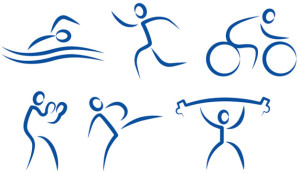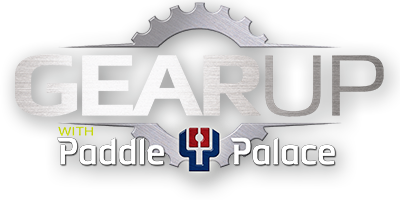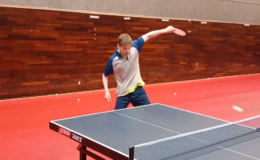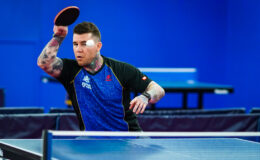
Physical Preparation for Table Tennis
by Christian Lillieroos, Lillieroos Institute for Table Tennis (LITT)
If we are looking at Table Tennis in terms of its physical characteristics you see a sport that is very different from other sports and it needs special preparation that is pretty unique.
What are the time parameters of Table Tennis?
1) One point last on an average of 3 seconds and it has an average of 10 seconds break in between points.
2) One game is 20 points (11-9) and takes about 4 minutes, then you have 1 minute break.
3) A match is for national level players best 3 out of 5 games and takes if it goes to 5 games about 25 minutes, a player in a tournament repeats that about 5 times in a day. If you look at that time frame you will do 2 hours of medium intense aerobic work in a day in a tournament.
Our body has 3 basic energy systems and Table Tennis uses 2 of them all the time, but not the third one.
1) Alactic anerobic: This means this energy system does create lactic acid, and do not use oxygen as its main energy. You use this energy system for about the first 15 seconds of high intense work. A typical sport that only uses this system is 100 meter sprints. Table Tennis uses this every point.
2) The second energy system is Lactic Anaerobic, which means that this system creates lactic acid, but is not using oxygen as its main energy. This starts at 15 seconds to about 1 minute of high intense work. Typical sports that use this system are 400 meters running, downhill skiing. Table Tennis do not use this system. We never get to a lactic acid state. If we do, we will miss and cannot play.
3) The third system is aerobic. This means this it uses as its main source of energy Oxygen. This starts from 1 minute to about 1.5 hours. After that you have a conversion that uses more fat combined with oxygen as its energy source when all glycogen is used up, but Table tennis do not get to that state but marathon runners do. Table Tennis use aerobic as its main energy source over many repetitions of short spurts and is an aerobic sport.
In conclusion Table Tennis is an Alactic/Anerobic and Aerobic sport. Both energy systems need training, but we need to be very careful that we do not get into lactic anaerobic training.
The Alactic Anareobic training is best done for table tennis in intense speed work (5 second work, 10 sec rest, repeat 20 times), and weight training with low reps (4-6 reps) heavy weights (~80% of max weight in each exercise) short rest in between sets of 1 minute, 20 sets in a session (1 hour).
Example Speed work: Run 20 meters at 90% speed, rest 10 second, repeat 20 times.
Example Weight training: You split your body in segments depending on how many years you have done weight training from body Split in 1 all the way to body split in 6. The first year is only light weights to get used to proper technique and normally 15 reps each set. If you for example are doing body split in 4 (after 4 years of training weights), you have 2 sessions on upper body and 2 sessions on lower body per week. If you are working on lower body and for example have “back bar squat” as you exercise you would start with 2 sets of warm up where you gradually increase the weight first warm up 15 reps, second warm up 10 reps, then you start your first work set at 8 reps then the second set increase the weight and do 6 reps then the third set increase the weight again and do 4-6 reps, that set is best done with a spotter. To lift heavy weight takes years to do properly, and is difficult to execute, and can be dangerous if done incorrectly.
The aerobic long time intervals (minimum 30 minutes) can be done by running, bike, or swimming or a combination of the three.
The interval training is easiest done running or on a exercise bike 4 minutes intense activity, rest 1 minute repeat 5 times.
The best sequence is to first run 30 minutes for a month or 2, then go to interval training for 2 months then you should be ready for intense table tennis training, multi ball, hard footwork drills etc.
Normally you train for 6 months to get ready for a tournament then you start all over again. In USA we normally have our big tournaments US Open in the summer July, and North American Open Team championship at the end of November and US Nationals in mid December. These are long physically demanding tournaments that need proper planning 6 months in advance to be properly prepared physically.
Year 1 in advanced training (This is normally the third year of playing or over 10 years old or over 1500 in rating)
Month 1&2, Aerobic 1 time a week running 30 minutes, Weights Whole body 1 time a week, Table tennis 4 times a week 2 hours.
Month 3-4 Same
Month 5-6 same
Year 4 in training, and at least over 15 years old
Month 1-2 Aerobic 30 minute running 2 times a week, Weights 4 times per week, Table Tennis 6 times per week 1 hour
Month 3-4, Aerobic 3 times per week interval 4 min rest 1 min times 5, Weights 2 times per week, speed work once per week. Table Tennis 6 times per week
Month 5-6 Aerobic 30 min running once per week, Weights 1 time per week, Speed work 4 times per week. Table Tennis 10 sessions per week. 1 day rest
The importance of physical preparation for a Table tennis athlete start to take effect after about 3 years of playing. You need to first learn basic strokes like loops, do spinny serves, return spinny serves, basic footwork. If you have great physical abilities but cannot return a serve, something went wrong in your priorities in your training.
TABLE TENNIS WEIGHT LIFTING
SESSION OPTIONS
| Weight Lifting – Single Session | ||||
| Muscle grp | Exercise | sets | Description | |
| Chest | Bench press | 3 | 15-12-10 | |
| Back | Latt pull | 3 | 15-12-10 | |
| Shoulders | Shoulder press | 2 | 15-12-10 | |
| Legs | Back Squats | 3 | 15-12-10 | |
| Leg press | 2 | 15-10 | ||
| Calves | Standing calve pres | 3 | 15-12-10 | |
| Abs | Crunches | 2 | 15-15 | |
| Weight Lifting – Split Session (2 sessions) | ||||
| Upper body | ||||
| Muscle grp | Exercise | sets | Description | |
| Chest 1) | Bench press | 3 | 15-15-12 | |
| Chest 2) | Chest fly | 3 | 15-15-12 | |
| Back 1) | Latt pull | 3 | 15-15-12 | |
| Back 2) | Row machine | 3 | 15-15-12 | |
| Shoulders | Shoulder press | 3 | 15-15-12 | |
| Arms | Bar Biceps curl | 2 | 15, 15 | |
| Triceps press | 2 | 15, 15 | ||
| Lower body | ||||
| Muscle grp | Exercise | sets | Description | |
| Legs | Back Squats | 3 | 15-15-12 | |
| Leg extention | 3 | 15-15-12 | ||
| Leg curls | 3 | 15-15-12 | ||
| Calves | Standing calve pres | 3 | 15-15-12 | |
| Sitting calve press | 3 | 15-15-12 | ||
| Abs | Crunches | 2 | 15-15 | |
| Side abs crunch | 2 | 15-15 | ||
| Weight Lifting – 3 Split Session | ||||
| Upper body | ||||
| Muscle grp | Exercise | sets | Description | |
| Chest 1) | Bench press | 3 | 15-12-10 | |
| Chest 2) | Chest fly | 3 | 15-12-10 | |
| Back 1) | Latt pull | 3 | 15-12-10 | |
| Back 2) | Row machine | 3 | 15-12-10 | |
| Arms | Bar Biceps curl | 3 | 15, 12.10 | |
| Triceps press | 3 | 15, 12,10 | ||
| Lower body | ||||
| Muscle grp | Exercise | sets | Description | |
| Legs | Back Squats | 3 | 15-12-10 | |
| Leg extention | 3 | 15-12-10 | ||
| Leg curls | 3 | 15-12-10 | ||
| Leg press | 3 | 15-12-10 | ||
| Calves | Standing calve pres | 3 | 15-12-10 | |
| Sitting calve press | 3 | 15-12-10 | ||
| Shoulder/Mid section | ||||
| Muscle grp | Exercise | sets | Description | |
| Shoulder | Shoulder press | 3 | 15-12-10 | |
| Lateral shoulder lift | 3 | 15-12-10 | ||
| Lower back | Back extention | 3 | 15-12-10 | |
| Abs | Straight Abs | 3 | 15-12-10 | |
| Side abs | 3 | 15-12-10 | ||
| Forearms | 3 | 15-12-10 | ||
| Weight Lifting – 4 Split Session | ||||
| Chest/Back | ||||
| Muscle grp | Exercise | sets | Description | |
| Chest 1) | Bench press | 3 | 15-10-8 | |
| Chest 2) | Chest fly | 3 | 15-10-8 | |
| Chest 3) | Incline press | 3 | 15-10-8 | |
| Back 1) | Latt pull | 3 | 15-10-8 | |
| Back 2) | Row machine | 3 | 15-10-8 | |
| Back 3) | Straight arm pull | 3 | 15-10-8 | |
| Upper Leg | ||||
| Muscle grp | Exercise | sets | Description | |
| Quads | Back Squats | 3 | 15-10-8 | |
| Leg extention | 3 | 15-10-8 | ||
| Leg press | 3 | 15-10-8 | ||
| Hamstrings | Leg curls | 3 | 15-10-8 | |
| Sitting Leg curls | 3 | 15-10-8 | ||
| Gluts | Lunges | 3 | 15-15-15 | |
| Shoulder/Arms | ||||
| Muscle grp | Exercise | sets | Description | |
| Shoulder | Shoulder press | 3 | 15-10-8 | |
| Lateral shoulder lift | 3 | 15-10-8 | ||
| Rotary cuff | 3 | 15-10-8 | ||
| Arma | Bicep curl | 4 | 15-12-10 | |
| Abs | Tricep press | 4 | 15-12-10 | |
| Forearms | 4 | 15-12-10 | ||
| Lower leg/Core | ||||
| Muscle grp | Exercise | sets | Description | |
| Calves | Standing calve pres | 3 | 15-12-10 | |
| Sitting calve press | 3 | 15-12-10 | ||
| Donkey calves | 3 | 15-10-8 | ||
| Lower back | Back extention | 3 | 15-12-10 | |
| Abs | Straight Abs | 3 | 15-12-10 | |
| Side abs | 3 | 15-12-10 | ||




